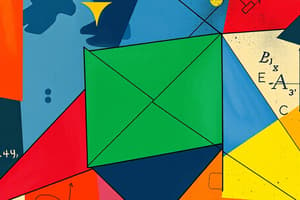Podcast
Questions and Answers
Which geometric element extends infinitely in two directions?
Which geometric element extends infinitely in two directions?
- Array
- Segment
- Ray (correct)
- Point
What is the geometric element that connects two points and has a beginning and an end?
What is the geometric element that connects two points and has a beginning and an end?
- Array (correct)
- Line
- Point
- Plane
What type of geometric element has a beginning but no end and one arrow?
What type of geometric element has a beginning but no end and one arrow?
- Ray (correct)
- Line
- Segment
- Array
Which geometric element shares the same plane as the segments it connects?
Which geometric element shares the same plane as the segments it connects?
What do non-collinear points determine?
What do non-collinear points determine?
When do two lines share the same plane?
When do two lines share the same plane?
What is the intersection of two planes?
What is the intersection of two planes?
Flashcards are hidden until you start studying
Study Notes
- A point is a dot in space.
- A segment connects two points and has a beginning and an end.
- An array or ray has a beginning but no end and one arrow.
- A line has no beginning or end and extends infinitely in two directions.
- Points are collinear if they lie on the same line.
- Three or more collinear points determine exactly one plane.
- Coplanar points lie on the same plane.
- Non-coplanar points do not lie on the same plane.
- A plane can be determined by three non-collinear points, a line and a point, or two parallel lines.
- Two intersecting lines share the same plane.
- Coplanar lines exist on the same plane.
- Coplanar segments share the same plane as the segments they connect.
- Points determine the plane they lie on.
- Intersection of two planes is a line.
- A line and a point determine the plane they belong to.
Studying That Suits You
Use AI to generate personalized quizzes and flashcards to suit your learning preferences.




